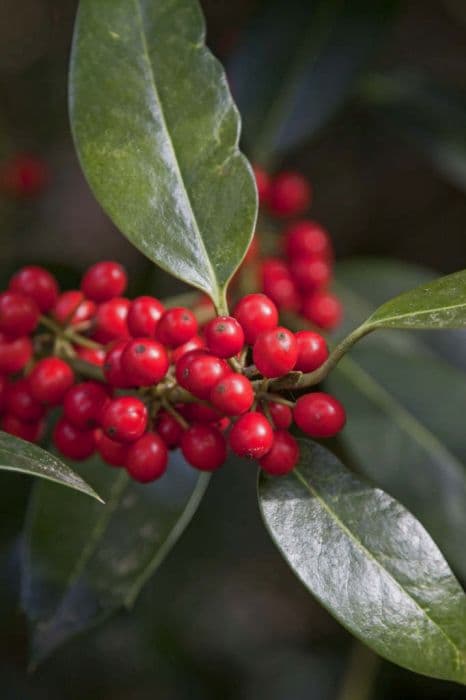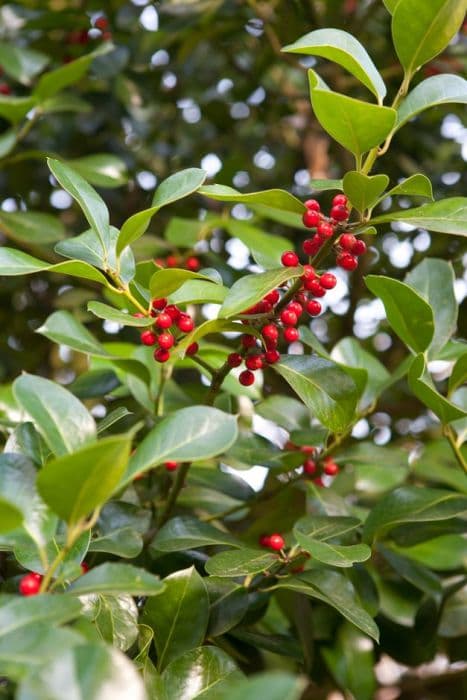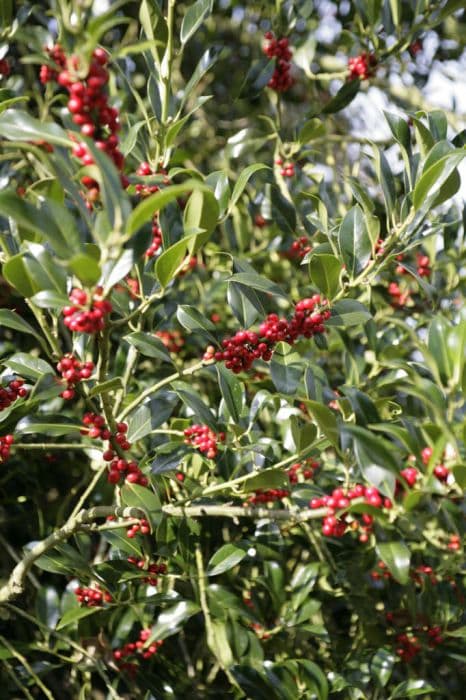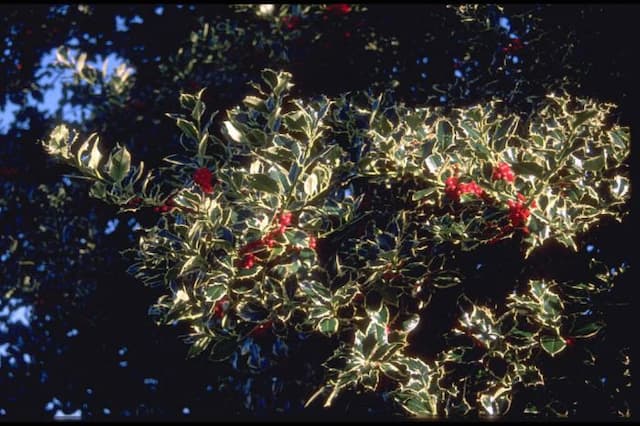English Holly Ilex aquifolium 'J.c. van Tol' (f)

ABOUT
The Ilex aquifolium 'J.C. van Tol', commonly known as the Holly, is an evergreen shrub renowned for its rich, dark green foliage and striking red berries. The leaves of this particular cultivar are less spiny compared to the typical holly, often possessing only a few soft spines or being entirely spine-free. They maintain a glossy sheen and have a slightly waved edge that contributes to the plant's visual appeal. Flowering in late spring, the Holly 'J.C. van Tol' produces small, inconspicuous white flowers that are followed by a profusion of bright red berries. These berries are a highlight in the winter garden, offering a pop of color against the greenery and providing food for birds. The berries are noticeable from fall right through to winter, sometimes persisting into the new year if not devoured by wildlife. The overall impression of this Holly cultivar is one of a lush, dense shrub with a classic and festive appearance, making it a favorite for holiday decorations and an attractive year-round plant for gardens. It can be used as a specimen plant, in borders, for hedging, or even in large containers, offering versatility in its use in the landscape. The Holly 'J.C. van Tol' holds up well in various soil types and is reasonably drought-tolerant once established, although it prefers a well-draining site.
About this plant
 Names
NamesSynonyms
J.C. Van Tol Holly, English Holly, European Holly.
Common names
Ilex aquifolium 'J.C. Van Tol'
 Toxicity
ToxicityTo humans
The common name for Ilex aquifolium 'J.C. van Tol' is Holly. Holly is considered to be mildly toxic to humans when ingested. The plant contains saponins, which can cause nausea, vomiting, diarrhea, and abdominal pain if eaten in large quantities.
To pets
Holly is also toxic to pets including dogs and cats. When pets consume Holly, they may experience symptoms such as drooling, lip smacking, vomiting, diarrhea, loss of appetite, and lethargy. Severe cases of Holly ingestion can lead to dehydration and drowsiness, so it is important to contact a veterinarian if you suspect your pet has eaten any part of this plant.
 Characteristics
CharacteristicsLife cycle
Perennials
Foliage type
Evergreen
Color of leaves
Green
Flower color
White
Height
6-10 feet (1.8-3 meters)
Spread
6-10 feet (1.8-3 meters)
Plant type
Shrub
Hardiness zones
5-9
Native area
Europe
Benefits
 General Benefits
General Benefits- Aesthetic Appeal: Ilex aquifolium 'J.C. van Tol', commonly known as Holly, adds visual interest with its glossy green leaves and red berries.
- Wildlife Habitat: Provides food and shelter for birds and other wildlife, especially in winter when resources are scarce.
- Low Maintenance: Generally easy to care for, requiring minimal pruning and being relatively pest and disease resistant.
- Privacy Screen: Can be used as a dense hedge or screen, offering privacy and reducing noise pollution.
- Winter Interest: Retains its foliage and berries in winter, providing color and structure in otherwise barren landscapes.
- Versatility in Landscape: Suits various garden styles, from formal to wild, and can be trained into different shapes.
- Evergreen Foliage: Keeps its leaves year-round, ensuring continuous coverage and greenery in the garden.
- Tolerance of Conditions: Adapts to a range of soil types and tolerates urban pollution and coastal conditions.
- Safety: The 'J.C. van Tol' cultivar has fewer spines than other hollies, making it safer for areas with pedestrian traffic.
 Medical Properties
Medical PropertiesThis plant is not used for medical purposes.
 Air-purifying Qualities
Air-purifying QualitiesThis plant is not specifically known for air purifying qualities.
 Other Uses
Other Uses- Ilex aquifolium 'J.C. van Tol', commonly known as Holly, can be used in topiary or formal hedging due to its dense growth habit and ability to tolerate pruning well.
- The wood of Holly is hard and dense, making it suitable for crafting fine furniture, inlays, or veneers.
- Holly branches are often used to fashion walking sticks or canes, adorned with its characteristic spiky leaves for a decorative effect.
- The plant's spiny leaves can provide physical deterrents for garden areas requiring protection from wildlife such as deer or rabbits.
- Holly's bright red berries can be used to create natural dyes or pigments for art and textile coloring.
- During winter months, Holly can be used in bird gardens; the berries provide a valuable food source for various bird species.
- In folklore and tradition, Holly is often used to craft wreaths or decor during winter festivities, symbolically bringing protection and good luck to homes.
- The plant can be included in sensory gardens, as its textured leaves and bright berries provide visual and tactile interest for visitors.
- Holly can be used as a natural barrier or fence, as its thick growth and prickly leaves form a living wall that is difficult to penetrate.
- In photography and cinematography, Holly's striking appearance makes it excellent for framing shots and creating natural set pieces, especially around festive seasons.
Interesting Facts
 Feng Shui
Feng ShuiThe Holly is not used in Feng Shui practice.
 Zodiac Sign Compitability
Zodiac Sign CompitabilityThe Holly is not used in astrology practice.
 Plant Symbolism
Plant Symbolism- Protection and Defense: The common name of Ilex aquifolium 'J.C. van Tol' is Holly. Due to its spikey leaves, holly symbolizes protection and defense, suggesting it acts as a guard against negative influences.
- Festivity and Celebration: Holly is famously associated with Christmas, representing joy, festivities, and seasonal cheer, often used in decorations during the holiday season.
- Endurance and Perseverance: Being an evergreen plant, holly symbolizes continuity and the ability to endure through hard times, maintaining vitality throughout the year.
- Good Fortune: In some traditions, holly is thought to bring good luck and is often planted near homes for this purpose.
- Hope: The brightness of holly berries in winter can symbolize hope and the promise of renewal, even when the surroundings are bleak.
 Water
WaterThe English Holly 'J.C. van Tol' prefers a consistent and moderate moisture level, so it's important to water the plant when the top inch of soil feels dry to the touch. Generally, this may equate to watering with approximately 1-2 gallons per week, depending on climate conditions and soil drainage. During hot, dry periods, this frequency may increase, whereas, during the winter, watering should be reduced. Always avoid waterlogging by ensuring the plant has well-draining soil and never let the soil stay soggy. Slight adjustments to the watering schedule may be necessary to accommodate for rainfall and seasonal changes.
 Light
LightEnglish Holly 'J.C. van Tol' thrives best in a location with full sun to partial shade. Ideally, it should receive at least 4-6 hours of direct sunlight daily but can benefit from filtered light or afternoon shade in hotter climates. A spot that offers morning sunlight with protection from the intense afternoon heat is optimal, helping to promote healthy growth and berry production.
 Temperature
TemperatureEnglish Holly 'J.C. van Tol' is hardy and can tolerate a wide range of temperatures; however, it grows best in areas where the temperature stays between 35-80 degrees Fahrenheit. It typically withstands minimum temperatures down to about 5 degrees Fahrenheit. To ensure optimal health and growth, avoid placing it in locations where winter temperatures regularly drop below this range.
 Pruning
PruningPruning English Holly 'J.C. van Tol' helps to maintain its shape and encourage bushier growth. The best time to prune is in late winter or early spring before new growth starts, but after the threat of extreme cold has passed. Remove any dead, damaged, or diseased branches, and trim to shape as desired. Pruning can be done annually or every couple of years, depending on the desired shape and size of the plant.
 Cleaning
CleaningAs needed
 Soil
SoilThe English Holly 'J.C. van Tol' prefers well-draining, loamy soil rich in organic matter. A mix with equal parts garden soil, peat moss, and perlite or sand would provide good aeration and moisture retention. The optimal soil pH for this holly should be slightly acidic to neutral, around 5.5 to 7.0.
 Repotting
RepottingEnglish Holly 'J.C. van Tol' usually requires repotting every 2 to 3 years. Choose a pot slightly larger than the root ball to allow for growth. Repotting is best done in late winter or early spring before new growth begins.
 Humidity & Misting
Humidity & MistingEnglish Holly 'J.C. van Tol' tolerates a wide range of humidity levels but prefers moderate to high humidity. Maintaining a level of 40-60% humidity is generally adequate for this plant's growth and health.
 Suitable locations
Suitable locationsIndoor
Place in bright, indirect light; water when topsoil is dry.
Outdoor
Partial to full sun; shelter from strong winds; mulch to retain moisture.
Hardiness zone
5-9 USDA
 Life cycle
Life cycleHolly 'J.C. van Tol' begins its life as a seed, which upon germination, emerges as a seedling with characteristic glossy green leaves with fewer spines than other hollies. As it matures into a young plant, it develops a strong root system and starts to form a woody stem. With time, it grows into a bushy evergreen shrub, reaching heights of up to 2-3 meters, and it begins to produce small white flowers in late spring, which are usually pollinated by bees. Following pollination, the female plants bear the iconic red berries, which persist through winter and are a vital food source for birds. Throughout its life, Ilex aquifolium 'J.C. van Tol' requires pruning to maintain shape and encourage healthy growth. The plant can live for several decades, surviving mild winters and continuing its cycle with seasonal flowering and berry production.
 Propogation
PropogationPropogation time
Early Spring
The Ilex aquifolium 'J.C. van Tol', commonly known as the English holly, is typically propagated during the late winter to early spring before new growth begins. The most popular method of propagation for this variety is by taking semi-hardwood cuttings. This involves selecting healthy, current year's growth that has started to harden but is not yet completely woody. A cutting of about 6 to 8 inches (approximately 15 to 20 centimeters) is made just below a leaf node. The leaves at the lower end of the cutting are removed, and the cut end is dipped in rooting hormone to enhance root development. The cutting is then placed in a well-draining rooting medium and kept under high humidity levels and indirect light until roots have developed, which can take several weeks to months. It's important to keep the soil evenly moist but not waterlogged to encourage rooting without causing rot.









